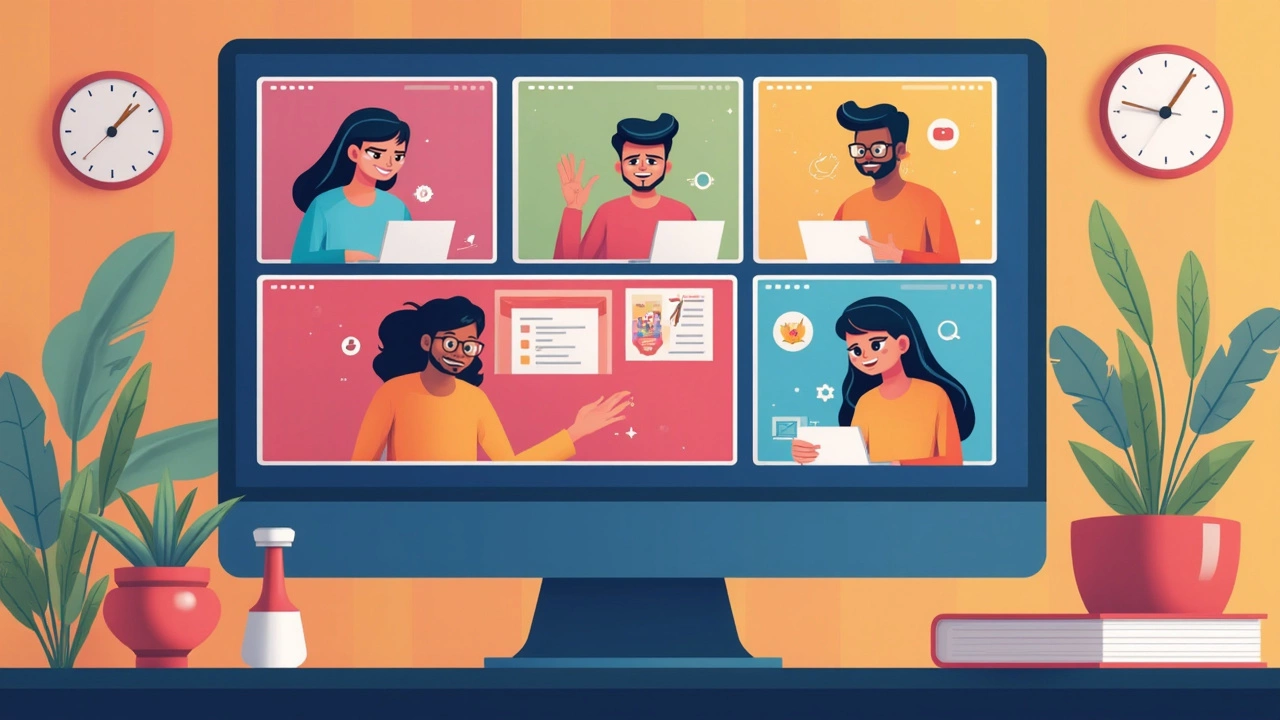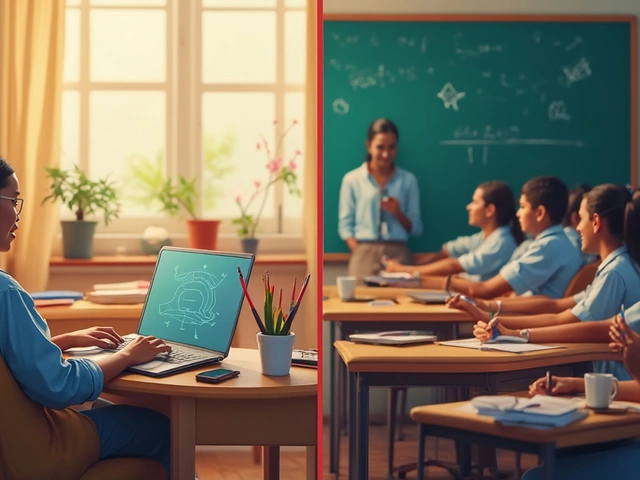Ever signed up for an online course, only to bail after the second lesson? Happens to almost everyone. The difference between a forgettable eLearning experience and a course that actually sticks? It boils down to the three P's: Plan, Produce, and Perform.
These aren’t buzzwords—they’re your practical cheat codes to creating eLearning that gets results. Mess up just one and your platform might as well be invisible. Nail them all and learners actually finish, remember, and use what you’re teaching.
Before jumping into tech tools or trendy designs, the smartest platforms get real about their goals and what students need. Forget guessing—let’s spell out the basics every eLearning pro should have on speed dial. Ready to make sure your course isn’t just one more tab someone closes?
- What Are the Three P's and Why Do They Matter?
- Planning: Setting the Stage for Success
- Producing: Crafting Content That Connects
- Performing: Engaging Learners and Measuring Impact
- Common Pitfalls and Bonus Tips for eLearning Platforms
What Are the Three P's and Why Do They Matter?
Too many folks think eLearning is just uploading a bunch of videos, slapping on some quizzes, and calling it a day. But the eLearning experience completely falls flat if you skip the three P’s: Plan, Produce, and Perform. These steps aren’t a fancy framework. They’re the nuts and bolts for everyone—from solo course creators to huge learning platforms like Coursera or Udemy.
You see the influence of the three P’s in the numbers. According to a 2024 eLearning Industry Survey, courses built with a structured plan and regular learner feedback got a 40% higher completion rate compared to courses that just tossed content online. Engagement and real-world results spike when you’re thoughtful about what you make and how you make it.
| Step | Basic Question | Why It Counts |
|---|---|---|
| Plan | What do my learners need? | Without it, you’re guessing and wasting effort. |
| Produce | How can I make this super clear? | Confusing content = checked out students. |
| Perform | Is the learning actually working? | No measurement, no improvement—or proof it matters. |
Here’s how they break down, real-world style:
- Plan: Nailing down what you want students to learn, how you’ll check progress, even when and where lessons happen.
- Produce: Turning ideas into bite-sized videos, interactive tasks, or visuals that aren’t boring or overwhelming.
- Perform: Watching the outcomes. This means checking analytics, collecting feedback, and changing things fast if something doesn’t work.
As Dr. Jane Bozarth, a leader in digital learning, puts it:
“If you don’t know where you’re going, any road will get you there. The three P’s make sure you’re actually headed somewhere learners want and need to be.”
So, whether you’re new to online education or want to take your next course up a level, keep the three P’s top of mind. Think of them as your GPS in the jungle of online learning. Skip them, and you’re just wandering around lost.
Planning: Setting the Stage for Success
Jumping straight into course creation without a solid plan? That’s a good way to lose your learners fast. In eLearning, everything starts with clear goals, a deep look at your target audience, and a mapped-out structure. This makes the difference between a hit course and just another online flop.
Start planning by asking yourself these questions:
- What’s the one thing you want learners to take away?
- Who’s your target audience—high schoolers, busy professionals, or total beginners?
- How much time will they realistically spend on each lesson?
- What devices will your audience use—laptops, tablets, or mostly smartphones?
Course designers who take time to do a basic needs assessment see higher engagement and fewer dropouts. A 2023 survey from the Online Learning Consortium found that courses built around specific learner profiles kept 43% more students from dropping out compared to generic, one-size-fits-all courses.
Then, break your course into logical modules. Think bite-sized—not marathon sessions. Here’s how a straightforward course plan might look:
| Module | Key Topic | Estimated Time |
|---|---|---|
| 1 | Introduction & Goals | 10 minutes |
| 2 | Core Concepts | 20 minutes |
| 3 | Real-World Examples | 15 minutes |
| 4 | Quiz & Review | 10 minutes |
Don’t wing it. Use real feedback—pilot your course with a few users before launch. A quick round of feedback can save you headaches down the road. Getting planning right upfront makes everything else smoother, from content to student support. And you’ll thank yourself when those completion stats go up.

Producing: Crafting Content That Connects
Let’s be honest, boring slides or endless reading aren’t going to keep anyone coming back. Good eLearning content feels like you’re chatting with someone who actually gets you, not a robot reciting a textbook. The big trick is making stuff clear, quick to grasp, and easy to act on.
Start by mixing up your formats. Don’t make everything a 10-minute video or a wall of text. People remember 65% of visual info three days later, compared to only about 10% of what they hear. Use images, short explainer clips, charts, and interactive quizzes. Even simple drag-and-drop questions boost focus and memory.
Another must: break things into small, ‘bite-sized’ chunks. Learners love microlearning because they can fit a lesson in between emails or meetings. A LinkedIn Learning survey in 2024 found that 57% of professionals prefer courses under 10 minutes per module. Keep videos short, split the main points, and package topics into easy-to-finish journeys.
Relate every lesson to real problems. If you’re teaching Excel, don’t just show buttons—make a mini project, like tracking expenses. Sprinkle in quick wins so students feel progress fast. That little shot of success keeps motivation up.
- Use a mix of text, audio, and visuals—never just one style.
- Chunk lessons so each module tackles one goal or skill.
- Set up knowledge checks: flashcards, short quizzes, or quick polls work wonders.
- Add interactive activities or discussion prompts, even if it’s just a two-minute reflection.
Here’s a snapshot of what works (and what doesn’t):
| Approach | Completion Rate | Average Satisfaction |
|---|---|---|
| Chunked micro-modules | 72% | 4.6/5 |
| Long-form lectures | 38% | 3.1/5 |
| Interactive quizzes | 68% | 4.4/5 |
| Text-heavy PDFs | 25% | 2.7/5 |
See the pattern? Short, interactive pieces not only get better ratings—they actually get finished. That’s what separates the stars from the duds on online learning platforms. Make every lesson practical and you’re halfway there.
Performing: Engaging Learners and Measuring Impact
It’s one thing to have well-written lessons, but it’s another to keep students awake and actually learning. Performance goes way beyond putting a quiz at the end. Engagement is the secret sauce—without it, even the most polished eLearning content collects digital dust.
Interactive features grab attention fast. Think polls, drag-and-drop exercises, and real-time discussions. Studies from EdTech Magazine found that eLearning platforms with gamified elements see student participation rise by about 60%. Simple tools like badges, leaderboards, or short competitions can make a huge difference.
But engagement isn’t just about flashy add-ons. It also means creating opportunities for students to apply what they learn—action beats passivity every single time. Try things like:
- Scenario-based questions that mirror real work challenges
- Group projects using online breakout rooms
- Peer reviews for assignments
Checking if your content actually works is just as important. This is where measuring impact comes in. Don’t just count course completions—look at how much people remember and use. Effective platforms use check-in surveys, learning analytics, and feedback loops.
Here’s a quick look at how eLearning platforms measure impact compared to traditional classrooms:
| Method | eLearning Platforms | Traditional Classrooms |
|---|---|---|
| Completion Rates | Often tracked automatically (average 40-60%) | Tracked manually (70-90% with attendance requirements) |
| Quiz Scores | Real-time data dashboards | Pencil-and-paper or basic gradebooks |
| Participation | Clicks, time on task, discussion posts | Teacher observation |
| Feedback | Instant surveys, automated ratings | End-of-term forms or one-on-one chats |
If you want learners to come back, you have to ask—and actually listen. Use quick polls after each section to check what’s working. Make tweaks based on real student feedback, not just gut feelings. An eLearning report last year said platforms that update their courses based on ongoing feedback see a 30% jump in student satisfaction scores.
Bottom line: performance isn’t about being flashy. It’s about keeping students plugged in and making it super clear what’s working (and what isn’t). Adjust on the fly, and the impact will stick long after the course ends.

Common Pitfalls and Bonus Tips for eLearning Platforms
Even some of the big-name eLearning platforms fall into the same traps again and again. You’d be surprised how much good planning can be undone by a few basic mistakes—or how easy it can be to boost your course with just a couple of clever tweaks.
Here are some of the most common pitfalls:
- Too much text, too few visuals: People remember images and short videos way better than blocks of text. Don’t expect anyone to dig through a 3,000-word lecture and remember what matters.
- No clear learning path: If it’s not obvious what to do next, learners will just stop. Confusing navigation wrecks completion rates.
- Lack of engagement: Just recording yourself reading slides isn’t enough. Quizzes, polls, even short discussion threads help people actually learn.
- Zero feedback: Learners who get no feedback are way more likely to drop out. It doesn’t have to be fancy; even small automated comments can make a difference.
- Ignoring mobile users: Over 60% of online learners use their phones or tablets. If your course chokes on smaller screens, half your audience could check out on day one.
Practical bonus tips for getting it right:
- Chunk your content: Break lessons into 5–10 minute pieces. Bite-sized feels doable and keeps attention up.
- Add real-world examples: Students remember more when they can see how a skill or concept connects to their everyday life. Even using a Starbucks order or Netflix subscription as examples can make abstract ideas clear.
- Automate reminders: Platforms with built-in reminder tools see up to 22% higher course completion rates.
- Test everything on mobile: Don’t just guess your content looks good—check it yourself or use emulator tools.
- Keep instructions simple: Learners bail when directions read like a puzzle. A quick one-line instruction usually does the job.
Check out how these factors stack up in real numbers:
| Pitfall/Tip | Impact (Based on Industry Studies) |
|---|---|
| Clear navigation | Completion rates increase by up to 30% |
| Mobile optimization | Increases user engagement by 2x (EdTech Magazine, 2023) |
| Short lessons | Dropout rates decrease by 20% (Coursera internal data, 2022) |
| Regular feedback | Learner satisfaction jumps by 35% |
| Automated reminders | Boosts course completion by up to 22% |
It’s easy to get caught up in flashy features and forget what makes eLearning really work. Platforms that focus on these basics end up with happier, more successful learners. If your course can dodge these traps and follow a few winning tips, you’ll see better retention, reviews, and actual results.








